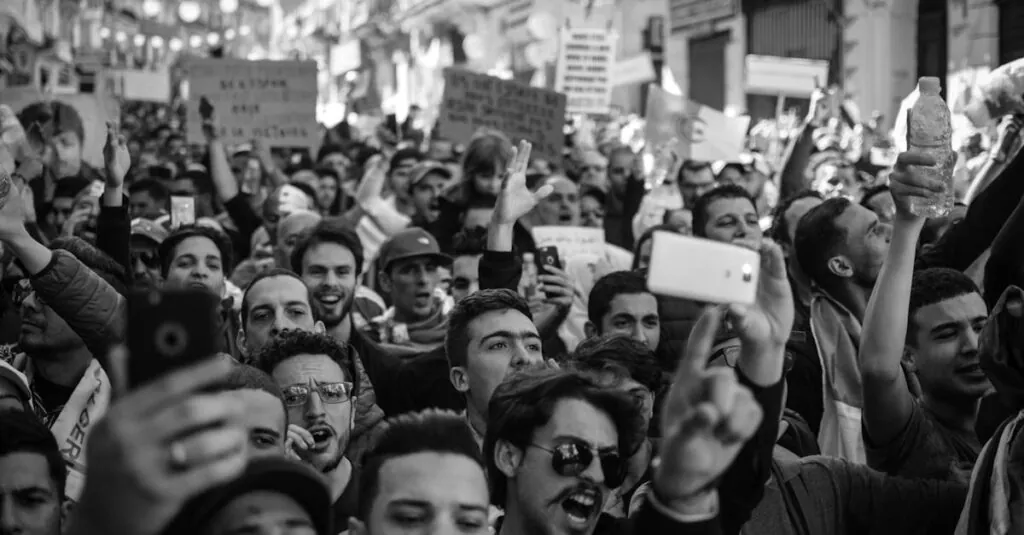Table of Contents
ToggleIn a world where social media reigns supreme and everyone’s got something to say, civic expression pieces have emerged as the unsung heroes of public discourse. These creative outlets allow individuals to voice their opinions, challenge norms, and spark conversations that matter. Whether it’s a bold mural on a city wall or a thought-provoking blog post, these pieces are more than just art; they’re the heartbeat of a community.
Imagine a world where everyone’s ideas are celebrated like the latest viral cat video. Civic expression pieces make that possible, encouraging people to engage with their surroundings and each other. They blend creativity with advocacy, proving that art can indeed change the world—one quirky post at a time. So, if you’ve ever wanted to make a statement without shouting from the rooftops, it’s time to dive into the vibrant world of civic expression.
Overview of Civic Expression Pieces
Civic expression pieces serve as significant platforms for individuals to voice opinions and encourage community engagement. These creative works, including murals, essays, and social media posts, foster meaningful dialogue and challenge societal norms.
Definition and Importance
Civic expression pieces encompass a variety of creative works that convey societal viewpoints. They provide avenues for individuals to articulate their beliefs, experiences, and aspirations. Engaging in civic expression influences public opinion, fostering awareness about social issues. Importantly, such pieces ignite conversations that lead to community growth and societal change. These expressions empower marginalized voices, enabling them to reclaim narratives and influence public discourse.
Historical Context
Civic expression pieces trace back to ancient civilizations, where art and rhetoric conveyed political and social messages. Historical examples include political pamphlets during the Enlightenment and protest songs during the Civil Rights Movement. Both served as vital tools for shaping public sentiment and mobilizing communities. Over time, the evolution of technology expanded the mediums for civic expression, making it accessible to a wider audience. The rise of social media continues this trend, enabling real-time discussions and amplifying diverse voices across the globe.
Types of Civic Expression Pieces
Civic expression pieces encompass various forms, each contributing unique perspectives on societal issues. These creative works effectively engage communities and encourage dialogue.
Art and Literature
Visual art and literature are prominent forms of civic expression. Murals often transform public spaces, delivering powerful messages about social justice. Poetry and essays articulate personal experiences and provoke thought on critical issues. These artistic mediums inspire audiences to reflect on community challenges and envision solutions. Community art projects frequently involve local artists, uniting diverse voices to address shared concerns. Literature, from novels to short stories, offers insights into the struggles and triumphs of individuals, fostering empathy within readers. Both art and literature collectively enrich public discourse and catalyze societal change.
Digital Media and Social Networking
Digital media platforms expand the reach and influence of civic expression. Social networking sites allow individuals to share their thoughts instantly, sparking conversations that transcend geographical boundaries. Hashtags often organize movements, amplifying marginalized voices and issues urgently needing attention. Videos and live streams engage audiences in real time, promoting active participation in civic matters. Online blogs and podcasts provide accessible platforms for in-depth discussions, inviting community contributions and diverse narratives. The interactive nature of digital media fosters collaboration, encouraging collective action and activism among users. This shift toward online engagement enhances the dynamism of civic expression in today’s digital age.
Impact on Society
Civic expression pieces significantly affect society by raising awareness and fostering dialogue around pressing issues. Their diverse forms encourage engagement and reflection.
Promoting Awareness
Civic expression pieces elevate public consciousness about important societal issues. They often spotlight topics such as social justice, environmental concerns, and human rights. By presenting personal narratives and collective experiences, these creative works draw attention to marginalized voices. Art installations, murals, and essays provide impactful visual and textual representation, achieving resonance with audiences. The immediacy of social media amplifies these expressions, enabling rapid dissemination and sparking discussions that reach far beyond local communities. As individuals encounter these messages, they gain insights, fostering a culture of awareness and empathy.
Encouraging Dialogue
Civic expression pieces create vital spaces for dialogue among diverse groups. Through platforms like public forums, online discussions, and community art projects, different perspectives emerge. These interactions encourage critical thinking and deeper understanding of complex issues. Engaging in conversation about art or literature allows individuals to challenge assumptions and share personal stories. The dynamic nature of these exchanges fosters collaboration and collective action, igniting grassroots movements. The use of hashtags and digital platforms enhances participation, connecting activists and thinkers worldwide. Civic expression turns passive observation into active engagement, inviting ongoing conversations that motivate change.
Challenges Faced by Civic Expression Pieces
Civic expression pieces often encounter significant obstacles that hinder their effectiveness and outreach.
Censorship Issues
Censorship emerges as a primary challenge for civic expression. Governments or organizations may impose restrictions on certain viewpoints, limiting artistic freedom. Artists and writers face risks of suppression, which stifles important conversations around social issues. Content that critiques authority can prompt backlash, discouraging creators from expressing dissent. Public spaces or online platforms might restrict the display of specific works, impacting visibility. Some creators adapt their messages to evade censorship, thereby diluting their original intent. Artists seeking to provoke thought may find their work challenged or removed entirely. The fear of repercussions negatively affects the willingness to engage in meaningful discourse.
Misinterpretation and Backlash
Misinterpretation poses another hurdle for civic expression pieces. Audiences frequently misread the intent behind artworks, leading to unintended controversies. A piece meant to spark dialogue may evoke outrage instead, diverting attention from critical issues. Misunderstandings can lead to public backlash, prompting critics to attack the creator or the message. Artists often struggle to clarify their intentions amidst the noise of conflicting interpretations. Timing plays a crucial role, as reactions can vary based on societal contexts or recent events. Navigating these challenges becomes essential for individuals committed to fostering change through civic expression.
Future of Civic Expression Pieces
Civic expression pieces continue to evolve, reflecting changes in society and technology. Future platforms for these expressions will likely focus on accessibility and collaboration.
Evolving Platforms
Emerging technologies expand the avenues for civic expression. Virtual reality offers immersive experiences, allowing individuals to engage with social issues interactively. Mobile apps facilitate community exchanges, empowering citizens to voice opinions quickly. Podcasting provides a platform for deeper discussions around civic topics, often featuring diverse perspectives. Social media’s rapid growth has transformed how artistic messages reach audiences, creating opportunities for immediate feedback. Online campaigns harness global participation, amplifying local voices and concerns. Civic expression evolves with these platforms, adapting to the needs of a digitally connected society.
Role in Social Movements
Social movements rely heavily on civic expression pieces to generate momentum and unify supporters. Protest art captures public sentiment, often becoming symbols for broader causes. Creative works spark conversations that resonate beyond specific events, highlighting shared values and goals. Through storytelling, civic expressions reveal personal experiences that humanize abstract issues. This connection creates empathy, motivating individuals to take action. Collaborative initiatives further engage communities, blending various artistic forms to communicate complex ideas effectively. Active participation in civic expression amplifies social movements, fostering community pride and resilience.
Civic expression pieces are essential in shaping public discourse and driving social change. They empower individuals to voice their opinions and challenge societal norms while fostering community engagement. As these creative expressions evolve with technology, they continue to amplify marginalized voices and spark vital conversations around pressing issues.
The importance of participating in civic expression cannot be overstated. It transforms passive observation into active involvement, inviting everyone to engage in meaningful dialogue. By embracing and contributing to these expressions, individuals can help cultivate a more informed and empathetic society. Ultimately, civic expression serves as a powerful catalyst for community growth and resilience, ensuring that diverse perspectives are heard and valued.




